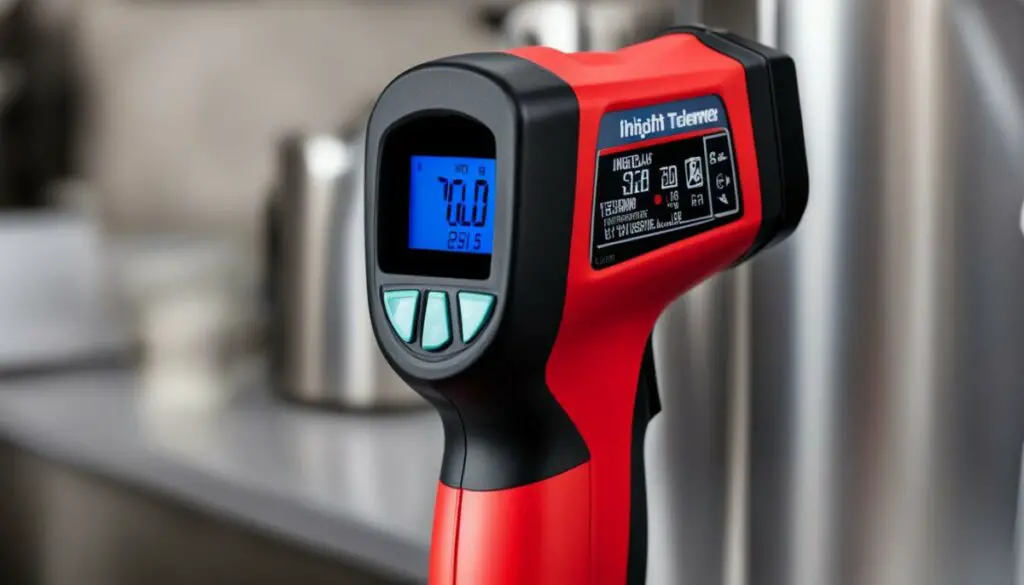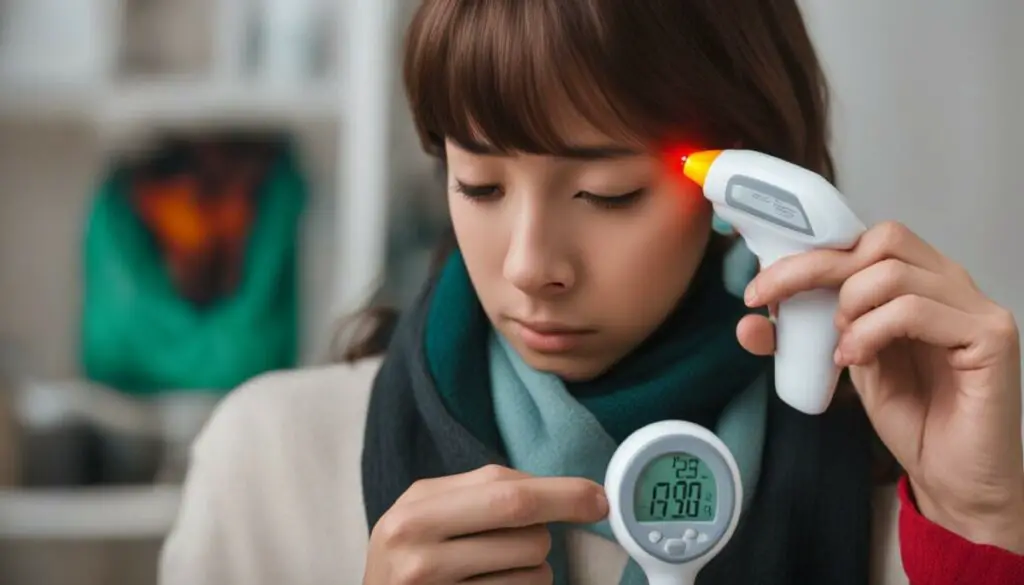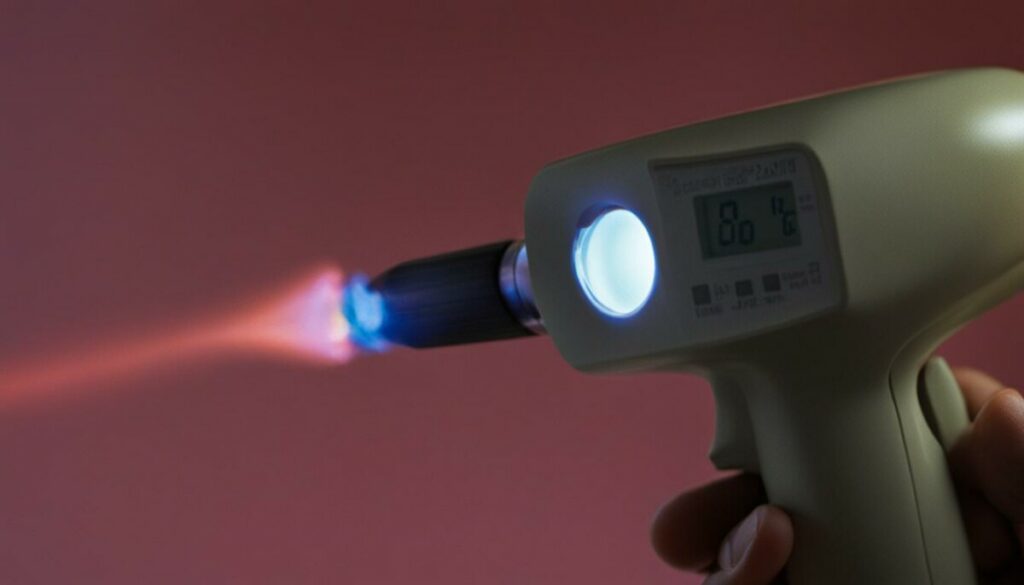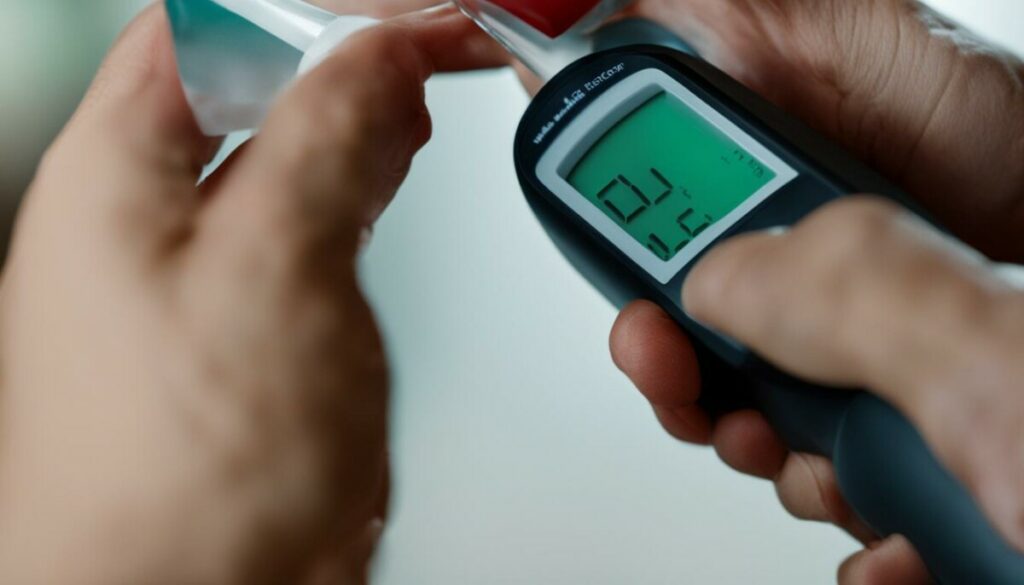Last Updated on 5 months by Francis
Have you ever needed to skip school or work but didn’t know how to do it convincingly? Faking a fever is a classic way out, and with the help of an infrared thermometer, it’s easier than ever. In this article, we will provide you with a comprehensive guide on how to simulate a high body temperature convincingly. With our tips and techniques, you’ll be able to feign sickness with ease and without getting caught.
First, let’s understand what an infrared thermometer is and how it works.
An infrared thermometer is a device that measures the temperature of an object or a surface without physical contact. It works by detecting the infrared radiation emitted by the object and translating it into a temperature reading. While these devices are primarily used for medical purposes, they can also be used to fake fevers.
Contents
Key Takeaways:
- An infrared thermometer can be used to simulate a high body temperature convincingly.
- The device measures temperature without physical contact by detecting infrared radiation.
Understanding Infrared Thermometers

Before we dive into the specifics of faking a fever, it’s crucial to understand how infrared thermometers work. These devices use infrared technology to measure the temperature of an object or person without making contact with the skin.
Infrared thermometers detect the infrared energy emitted by a person’s body and convert it into a temperature reading. They work by analyzing the thermal radiation emitted from the surface of the skin and turning it into an electrical signal. This signal is then displayed as a temperature reading on the device’s screen.
Now, you may wonder, can these readings be manipulated? Infrared thermometers are designed to provide accurate and reliable temperature measurements. However, some hacks can help you manipulate their readings to simulate a fever.
Here are some infrared thermometer hacks to keep in mind:
- Point the thermometer at a warm surface before using it, such as a lamp or a cup of hot water. This will raise the device’s temperature reading, making it easier to fake a fever.
- If your skin is cold, the infrared thermometer may not detect enough radiation to provide a temperature reading. You can warm up your skin by rubbing it or by using a warm compress before using the thermometer.
- Some infrared thermometers have a “calibration” feature that allows you to adjust the device’s temperature reading. Be careful not to adjust the reading too much, as it could raise suspicion.
Keep in mind that faking a fever can be challenging, and it’s essential to create a convincing illusion of warmth. In the next section, we will explore various techniques to raise your body temperature temporarily, making the infrared thermometer readings appear consistent with a fever.
Creating the Illusion of Warmth

One of the crucial steps in successfully faking a fever is to create the illusion of warmth in your body. This can be achieved through various ways, including:
- Wrapping yourself in blankets: Keep yourself warm by wrapping yourself in thick blankets. This will raise your body temperature and make it easier to feign a higher reading on the infrared thermometer.
- Drinking warm liquids: Consuming warm liquids such as tea or soup can help raise your body temperature temporarily, making the infrared thermometer readings appear consistent with a fever.
- Using a heat source: Placing a heating pad or hot water bottle on various parts of your body can also increase your body temperature temporarily. Be sure to move the heat source around to avoid burns and to maintain the illusion of fever.
- Physical activity: Engaging in light exercises or physical activity can also raise your body temperature temporarily. This can be accomplished through activities such as jumping jacks or jogging in place.
It’s important to note that all of these methods should be used in moderation and carefully monitored to prevent actual illness or injury.
To further increase the illusion of warmth during infrared temperature readings, you can try:
- Keeping the thermometer close to your body: Hold the thermometer as close to your body as possible, preferably under your armpit, to provide an accurate temperature reading.
- Using a warm washcloth: Place a warm washcloth on your forehead or the area where the thermometer will be placed to provide a more convincing illusion of fever.
- Applying a small amount of hand sanitizer: Applying a small amount of hand sanitizer or rubbing alcohol on the area where the thermometer will be placed can also raise your skin temperature temporarily, providing a higher reading on the thermometer.
By utilizing these techniques, you can create the illusion of warmth and successfully raise your body temperature when using an infrared thermometer to fake a fever.
Tips for Accurate Infrared Thermometer Readings

If you’re planning to fake a fever, it’s crucial to ensure that your infrared thermometer readings are accurate. Here are some tips for using the device correctly:
1. Clean the Skin
Before using your infrared thermometer, ensure that the skin on the forehead is clean and dry. Any dirt or moisture on the skin can affect the accuracy of the readings.
2. Position the Device Correctly
Hold the device perpendicular to the forehead and position it so that the infrared sensor is in line with the center of the forehead. This will ensure that the readings are accurate and consistent.
3. Keep a Consistent Distance
It’s important to maintain a consistent distance between the device and the skin to avoid getting inconsistent readings. Try to keep a distance of about 1-2 inches from the forehead while taking the measurements.
4. Take Multiple Readings
To ensure accuracy, take multiple readings and take an average of the results. This will help to account for any fluctuations in body temperature and will give you a more reliable reading.
5. Avoid Exposure to Extreme Temperatures
Avoid exposing your infrared thermometer to extreme temperatures, which can affect the accuracy of the device. Keep it at room temperature and avoid exposing it to direct sunlight or heat sources.
“Remember, if you’re not careful with the infrared thermometer, it can be easy for others to spot that you’re faking a fever. Practice using the device beforehand and ensure that you’re taking accurate and consistent readings.”
Understanding Fever Symptoms

To effectively fake a fever, it’s essential to understand the symptoms commonly associated with it. Knowing and mimicking these signs and symptoms will make your feigned fever appear more believable.
Some of the most common fever symptoms include:
- Elevated body temperature: A fever is defined as a body temperature above 100.4°F (38°C). You can use your infrared thermometer to ensure your simulated temperature aligns with this standard.
- Chills and shivers: A fever can cause you to feel cold and shivery, even if the room temperature is warm. Mimicking these symptoms can help convince others that you’re genuinely unwell.
- Headache: A headache is a common symptom of a fever, caused by the body’s response to the elevated temperature.
- Sweating: As your body tries to cool down and regulate its temperature, you may start to sweat more profusely.
- Dehydration: A fever can cause dehydration as the body loses water through sweating. You can simulate this by drinking less water and appearing more fatigued or lethargic.
It’s essential to mimic these symptoms convincingly, but don’t overdo it. If you exaggerate your symptoms, others may become suspicious and see through your act.
“It’s essential to mimic these symptoms convincingly, but don’t overdo it.”
Remember, it’s not just about simulating a fever; it’s also about acting like someone who is genuinely ill. Pay attention to your behavior, and try to mirror the signs and symptoms of a fever to make your performance more convincing.
Preparing Your Environment

Creating a convincing illusion of illness involves setting the right environment. Here are some tips on preparing your surroundings to ensure that your feigned fever appears authentic to others.
- Temperature: To simulate a fever convincingly, the room temperature should be warm. A temperature of 76 to 78℉ (24 to 26℃) is the best range to create the illusion of warmth. You can use a space heater or a thermostat to maintain the temperature. Just be careful not to overheat the room and cause actual health problems.
- Bedding: If you need to feign a fever while staying in bed, ensure that the sheets and blankets are disheveled, as if you have been tossing and turning in discomfort. Arrange pillows around you, as if you are propped up to alleviate symptoms like a headache or congestion.
- Clothing: Wear comfortable clothing that is appropriate for a sick person. Avoid heavy winter clothing as it can increase your body temperature too much and make the illusion less convincing. Choose light clothing instead, such as a t-shirt and sweatpants.
- Props: Use props like a box of tissues, a glass of water, and a thermometer to create a convincing illusion of illness. Keep them close by and use them as necessary to reinforce the idea that you are unwell.
By setting the right environment, you can help to convince others that you are genuinely ill. Remember to be consistent with your acting, as even the slightest slip-up can raise suspicion.
Timing and Duration

When it comes to faking a fever with an infrared thermometer, timing and duration are crucial factors to consider. You want to make sure that you initiate your plan at the right time and maintain the illusion for the appropriate duration to avoid arousing suspicion.
Firstly, you need to consider the time of day when attempting to raise your body temperature. The ideal time to start is in the morning when people are less likely to question your condition. Avoid initiating your plan during the day or at night when it may seem unusual to experience a sudden onset of illness.
The duration of your feigned fever is equally important. You don’t want to draw too much attention to yourself by allowing the illusion to persist for too long. A duration of 24 hours is sufficient enough to convince people that you have a fever without risking getting caught.
- Tip: Use the thermometer at different times throughout the day to ensure that the readings appear consistent with a fever. This will make it more difficult for others to suspect your feigned illness.
Remember that the goal is to simulate a high body temperature convincingly, but without attracting too much attention to yourself. By following these tips and raising your body temperature temporarily, you can successfully fake a fever with an infrared thermometer.
Dealing with Others’ Observations

When feigning a fever, it’s natural for people around you to become curious or concerned. You need to prepare for this carefully to avoid arousing suspicion or giving away your deception. Here are some tricks for faking a fever successfully:
- Be consistent with your actions: If you’re pretending to be sick, don’t suddenly start acting normal or energetic. Your behavior should be consistent with someone who is genuinely unwell. Avoid overacting since it may appear exaggerated and fake.
- Stay isolated: Isolation is key when feigning a fever. If possible, stay away from people to avoid drawing attention to yourself. If asked why you’re isolating yourself, explain that you don’t want to spread germs to others.
- Maintain a natural appearance: Even if you’re feeling fine, try to appear unwell. Avoid using too much makeup or dressing in a way that contradicts your “illness.”
- Use props: Simple props like tissues or a blanket can be used to make your feigned fever appear more convincing. Don’t overdo it or use props that look fake.
- Don’t sweat the small stuff: If someone notices inconsistencies in your “illness,” don’t panic. Instead, explain it away with plausible excuses, such as feeling better than you did earlier or taking medication that’s helping.
By following these tricks for faking a fever, you can manage others’ observations and maintain the illusion of illness.
Managing Fever Medications
In some cases, simulating a fever convincingly requires the use of fever-reducing medications. However, it is important to be cautious while taking such medications as they might lead to negative consequences. Ingesting these medications can cause you to have a lower body temperature, which would make your feigned fever appear less authentic.
If you must use fever-reducing medication, it is advisable to consume them in smaller doses and at longer intervals. This will help you maintain the illusion of a high body temperature without raising suspicion.
You should also ensure that the medication you use matches the symptoms you are attempting to mimic. For instance, if you have a headache or body aches that often accompany fevers, use medications that relieve those symptoms. Do not risk taking medications that could lead to adverse effects, such as nausea or vomiting, as this could make your feigned fever appear less realistic.
It is also advisable to take medications in the right environment and at the right time. For instance, consuming medication while in the presence of others could raise suspicion, so it is best to avoid doing so. Additionally, you should take medications at a time that does not interfere with your activities, as it could lead to inconsistencies in your feigned illness.
With proper management, fever-reducing medications can be an effective tool for simulating a fever. However, it is important to use them wisely and sparingly to avoid arousing suspicion and maintain the illusion of illness.
Conclusion
Successfully faking a fever with an infrared thermometer requires careful planning and execution of various techniques. By following the tips provided in this article, you can raise your body temperature convincingly when needed, without arousing suspicion.
Remember to understand the basics of infrared thermometers and use tricks to manipulate their readings. Creating the illusion of warmth through various methods and techniques is crucial, along with knowing how to handle the device properly to ensure accurate readings. Understanding fever symptoms and preparing your environment to match them can also help you feign a believable fever.
Timing and duration are crucial factors to consider, and you must also be prepared to handle inquiries, observations, skepticism, and even medication if necessary, to maintain the illusion of illness.
Overall, with the knowledge and skills provided in this article, you can confidently fake a fever with an infrared thermometer and achieve the desired results. So, go ahead and raise your body temperature convincingly when needed!
FAQ
Can faking a fever with an infrared thermometer be detected?
Faking a fever using an infrared thermometer can be difficult to detect if done correctly. However, there is always a possibility that someone may become suspicious, especially if they notice inconsistencies or unusual behavior.
Are there any risks involved in faking a fever?
Faking a fever with an infrared thermometer carries certain risks. It is important to consider the potential consequences, such as getting caught or facing disciplinary actions. Additionally, using fever-reducing medications without a legitimate medical reason can pose health risks.
Are there any legal implications of faking a fever?
While faking a fever itself may not have direct legal implications, there may be consequences in certain situations, such as employment or educational settings. It is essential to familiarize yourself with any rules, regulations, or policies that may apply before attempting to fake a fever.
Can I use any type of infrared thermometer to fake a fever?
It is recommended to use a reliable and accurate infrared thermometer to ensure convincing results. Different models may have variations in accuracy, so it is best to choose one that is commonly used and trusted.
How do I maintain consistency when faking a fever?
Consistency is key when faking a fever. You should carefully mimic the symptoms associated with a fever, such as lethargy, flushed skin, and generalized discomfort. Creating a believable narrative and avoiding contradictory behavior will help maintain consistency.
What if I am asked to provide evidence of illness?
If you are asked to provide evidence of illness, it is important to have a plan in place. Familiarize yourself with the policies and procedures of the context in which you are faking a fever and be prepared to provide any necessary documentation, such as a doctor’s note or medical certificate.
Are there any alternative methods to faking a fever?
Faking a fever is not the only way to achieve a desired outcome. It is worth exploring alternative strategies to achieve your goals without resorting to deception. Consider open communication, negotiation, or seeking alternative solutions that are more ethical and transparent.








